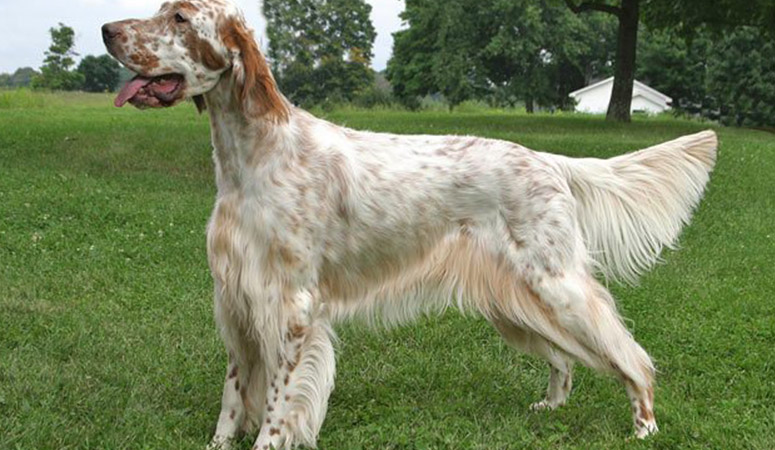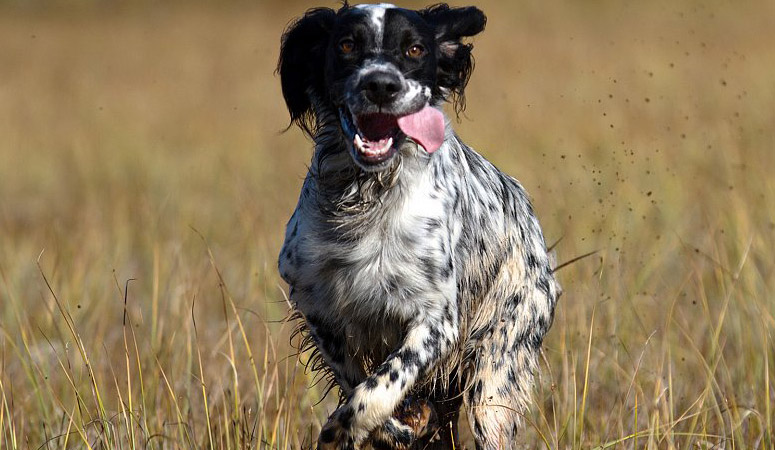English Setter

The English Setter is a medium-sized breed of dog, their coat is flat, with feathering on the ears, underside, backs of legs, the underside of thighs, and tail. They are gentle but sometimes strong-willed, combination with endurance and athleticism, they are used to hunt for games such as quail, pheasant, and grouse.
| Other Names | Englischer Setter, Setter Anglais, Setter Ingles, Setters |
| Color | Blue Belton, Blue Belton & Tan (Tri-Color), Lemon Belton, Liver Belton, Orange Belton, White |
| Height | Males: 23-27 inches. Females: 22-26 inches. |
| Weight | Males: 50-70 pounds. Females: 45-60 pounds. |
| Life Span | 12 years |
| Personality | Friendly, Mellow, Merry |
| Exercise | Energetic |
| Origin |
| Popularity | #98 |
| Groom Needs | 2-3 Times a Week |
| Kids Friendly | Yes with supervision |
| Dog Friendly | Yes with supervision |
| Watch Dog | |
| Family Dog | Yes |
| Litter Size | 4-6 |
English Setter Pictures
English Setter Video
Introduction
This is a medium-sized gun dog that is a part of the setter group of dogs. It is used to hunt for game such as pheasant, grouse or quail. Sometimes, it is referred to as the Laverack or Llewelin Setter because of the well-known strains of the breed during the 19th century. Those from the hunting stock can be distinguished from those bred for show exhibitions by their body build and coat, with those from the hunting stock having a better body build and lesser coat.
The head of the English setter should be domed slightly with a muzzle of good depth and its eyes should be dark in color and display a gentle expression. The ears are, sometimes, referred to as leathers and the top of them are placed in line with the eyes. It also has a long, muscular neck, good depth, and well-angled shoulders. It has good hindquarters as well and its body is of a moderate length in proportion to its height.
The length of the body coat varies between short to medium. It has a silky texture and lies flat. Its long silky coat is usually called feathering and it forms fringes on the outsides of the neck, ears, and chest and down to the back of the front legs, under the belly and on the back legs. White is the base color of the body coat and there are different colored ticking that accompany the white color. These tickings are referred to as speckling or flecks. Belton is the name by which the various flecked coat colors occurring in the English setter are known. The approved combinations are white with black flecks also known as blue belton, white with orange flecks, and lighter nose also known as lemon belton, white with orange flecks also known as orange belton, white with liver flecks also known as liver belton or “tricolor”. The specklings should not be distributed all over the body and not form large patches on the body. However, the puppies’ coat may not have all the markings that the adults do.
A male English setter weighs between 65 and 80 pounds and stands 25-27 inches at the shoulder. A female English setter weighs about 45-75 pounds and measures up to 23-25 inches at the shoulders. The average lifespan of an English Setter is around10-12 years.
Living with English Setter
English Setters need to be brushed at least once a week with a soft bristle brush to keep their long, silky coats beautiful, and use a steel comb to gently remove any tangles or mats. Daily brushing is better. They need a bath every two or three weeks unless they roll in a mud puddle.
Check and clean your English Setter’s ears every week with a gentle, dog-friendly cleanser to prevent dirt buildup that may cause infection. Brushing the teeth at least two or three times a week to remove tartar buildup and the bacteria that lurk inside it. And daily brushing is better to keep fresh breath and prevent gum disease. Besides, trim the nails every month to prevent cracking.
An English Setter needs regular exercise to stay happy and healthy, and adequate exercise can help him be a calm housedog. Ideally, this could be a daily vigorous run or play session in a large, securely fenced area, or the owner can take your dog to walk or hike on leash. And taking your English Setter to dog parks is a good idea. Obedience training is not only essential for control but also important for the mental exercise the dog needs. It is best to avoid very strenuous or high-impact activity with puppies and young dogs because English Setters’ bones and joints may not reach mature strength until two years of age.
Generally, it is recommended to feed an English Setter with two to three cups of high-quality dry dog food every day, divided into two or three meals. And there should be clean and fresh water at all times. More importantly, the food amount should depend on the dog’s weight, size, age, and activity level.
Some dogs are easy to get overweight, so you need to watch their calorie consumption and weight level all the time. Treats may be an important aid in training, but excessive intake can lead to obesity. Also, owners need to distinguish which human food is safe for dogs and which are not. If you have any problems with your dog’s weight or diet, just consult from your veterinarian.
English Setters are prone to the following health conditions: hypothyroidism, hip and elbow dysplasia, deafness, osteochondritis dissecans, epilepsy, progressive retinal atrophy, etc.
Major concerns: CHD, deafness, hypothyroidism, elbow dysplasia
Minor concerns: OCD, PRA
Occasionally seen: epilepsy
Suggested tests:
BAER Testing
Hip Evaluation
Elbow Evaluation
Thyroid Evaluation
Total Annual Cost: $2889
Cost is estimated for the first year and may vary depending on many factors, such as dog food, health care, leash, collar, licensing, possible fencing, crates, training and obedience classes, dog-walking, grooming, treats, toys, flea, tick, and heart-worm meds, microchips, etc.
English Setters are smart and willing to please, although they are strong-willed but can be easily distracted by the birds flying around the neighborhood during training. They can learn the basic commands quickly as long as the owner remains consistent and offer abundant positive reinforcement. Besides, they are sensitive dogs, it is better to train them with positive reinforcement rather than punishment.
The English Setter could be wonderfully companionable and pleasantly manageable in the home when given the appropriate exercise, attention, and training that he needs. And continued training is a good way to occupy your English Setter and prevent him from indulging layabout tendency. Besides, they can excel in agility training, advanced obedience training, and dog sports, such as dock jumping and flyball.
History
It seems like the English Setter was from more than 400 years ago and it was a trained bird dog from around that time in England. The setters were established in Britain and were widespread in various estates in the country by the 17th century. But the evolution of this breed into a more specific individual breed came later on. The English Setter was among some of the first purebred registrations accepted by the American Kennel Club when it was established in 1878.
Helpful Information
Breed Club: ENGLISH SETTER ASSOCIATION OF AMERICA, INC.
Breed Club Link: https://www.esaa.com/
Breed Club Rescue:
Breed Club Rescue Link: https://www.esaa.com/Rescue/index.html




